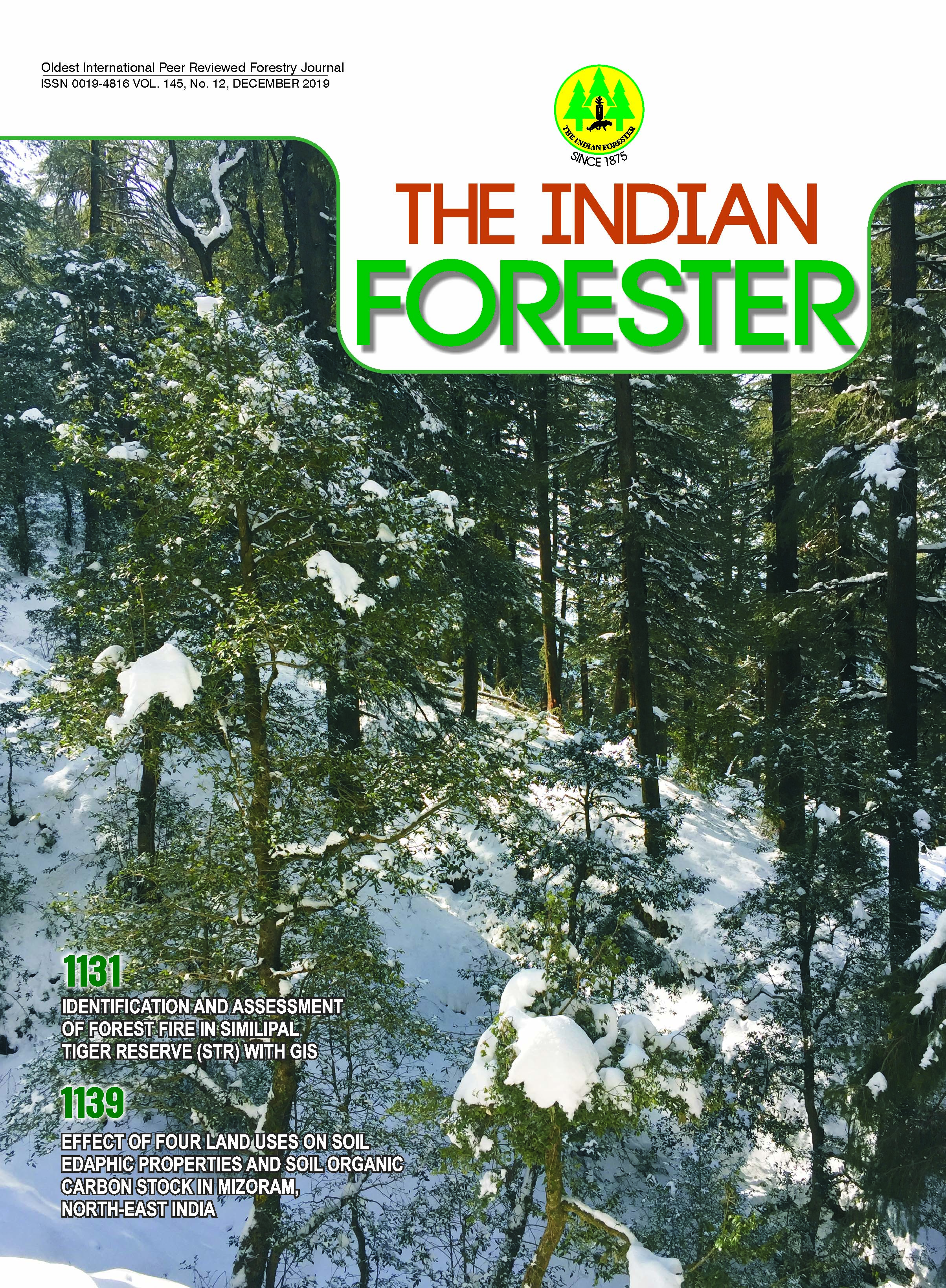Intercropping of Andrographis paniculata under Emblica officinalis in Western Himalayan Sub-Tropics
DOI:
https://doi.org/10.36808/if/2019/v145i12/150638Keywords:
Intercropping, Agri-Horticulture, Emblica officinalis, Andrographis paniculata, Agroforestry.Abstract
A field experiment was conducted to determine the feasibility of intercropping Andrographis paniculata Nees. and Emblica officinalis Gaertin. at Dry land Regional Sub Station of Sher-E-Kashmir University of Agricultural Sciences and Technology of Jammu. The objectives were to study the effect of ten-year-old Emblica officinalis trees on the growth and yield of Andrographis paniculata. Andrographis was intercropped at three different spacing viz., 30cm × 45cm; 30cm × 30cm; 45cm × 45cm. Recommended spacing of 30cm × 45 cm without trees served as control. The results showed that due to competition among the various components of the system, Andrographis paniculata grown as an intercrop registered a decrease in growth and productivity compared to open. However, on practical point of view, out of the three different spacing, plant spacing of 45 cm × 45 cm was found most suitable for successful cultivation of Andrographis paniculata as an intercrop under Emblica officinalis. We concluded that Andrographis paniculata - Emblica officinalis intercropping system can be practical and beneficial in the region. However, the distance between crops and tree rows should be adjusted to minimize interspecies competition.References
Bijalwan A. (2012). Structure, Composition and Diversity of Horticulture Trees and Agricultural Crops Productivity under Traditional Agri-Horticulture System in Mid Hill Situation of Garhwal Himalaya, India. American Journal of Plant Sciences, 3: 480-488.
Cannell M.G.R., van Noordwijk. M. and Ong. C.K. (1996). The central agroforestry hypothesis: the trees must acquire resources that the crop would not otherwise acquire. Agroforestry Systems, 34: 27-31
Chadha Y.R. (1985). The wealth of India: raw materials, Vol 1 A. CSIR, New Delhi, p 264.
Das D.K., Chaturvedi O.P., Jha R.K. and Rajeev Kumar (2011). Yield, soil health and economics of aonla (Emblica officinalis Gaertn.) based agri-horticultural systems in eastern India. Current Science, 101(6): 786-790.
Gomez K.A. and Gomez A.A. (1984). Statistical procedures for agricultural research (2nd ed.). John Wiley and sons, New York, 680p.
Jose S. (2009). Agroforestry for ecosystem services and environmental benefits: an overview. Agroforestry Systems, 76 (1):1-10.
Leakey R.R.B. and Simons A.J. (1998). The domestication and commercialization of indigenous trees in agroforestry for the alleviation of poverty. Agroforestry Systems, 38:165-176.
Magcale-Macandog D.B., Ranola F.M., Ranola R.F., Ani P.A.B., Vidal N.B. (2010). Enhancing the food security of upland farming households through agroforestry in Claveria, Misamis Oriental, Philippines. Agroforestry Systems, 79 (3): 327-342
McNeely J.A., Schroth G. (2006). Agroforestry and biodiversity conservation-traditional practices, present dynamics and lessons for the future. Biodiversity Conservation, 15:549-554
Ong C.K., Black C.R., Marshall F.M. and Corlett J.E. (1996). Principles of resource capture and utilization of light and water. In: Tree-Crop Interactions: A Physiological Approach.
Ong, C.K. and Huxley, P.A. Eds. CAB International and ICRAF, Wallingford and Nairobi, pp 73-158.
Patil S.J., Mutanal S.M. and Patil H.Y. (2012). Melia azedarach based agroforestry system in transitional tract of Karnataka. Karnataka Journal of Agriculture Science, 25(4): 460-462.
Raina Archana P., Gupta Veena; Sivaraj N. and Dutta M. (2013). Andrographis paniculata (Burm. f.) Wall. ex Nees (Kalmegh), a traditional hepatoprotective drug from India. Genetic Resources and Crop Evolution, 60(3): 1181-1189.
Ranote P.S., Hothe R.K. and Bawa A.S. (2002). Preparation, Evaluation and Storage of Preserve Made from Amla Cultivars Grown in Kandi Area of Punjab State. Journal of Scientific & Industrial Research, 61: 461-465.
Sehgal Sandeep and Raza Ali Abidi. (2015). Tree Planting Constraints in Traditional Agroforestry Practices in Dry lands of Sub Montane North Western Himalayas. Indian Forester, 141(3): 293-297.
Singh, Bilas, Bishnoi, M., Baloch M.R. and Singh, Genda (2014). Tree biomass, resource use and crop productivity in agri-horti-silvicultural systems in dry region of Rajasthan, India. Archives of Agronomy and Soil Science, 60(8): 10311049
Tewari J.C., Sharma A.K., Narain P. and Singh R. (2007). Restorative forestry and agroforestry in hot arid regions of India: a review. Journal of Tropical Forestry, 23:1-16.
Tiwari T. P., Brook R.M., Wagstaff P. and Sinclair F.L. (2012). Effects of light environment on maize in hillside agroforestry systems of Nepal. Food security, 4(1): 103-114.
Willey R.W. (1979). Intercropping and its importance and research needs. Part-I, competition and yield advantages. Field Crop Abstract, 32: 1-10.
Downloads
Downloads
Published
How to Cite
Issue
Section
License
Unless otherwise stated, copyright or similar rights in all materials presented on the site, including graphical images, are owned by Indian Forester.





